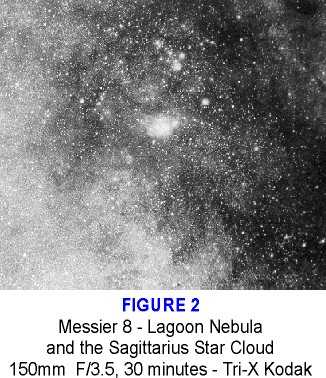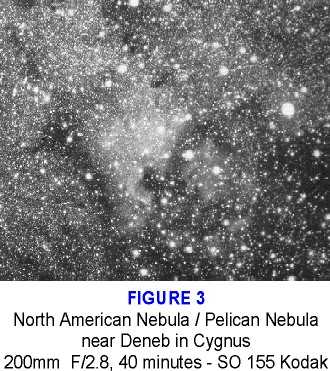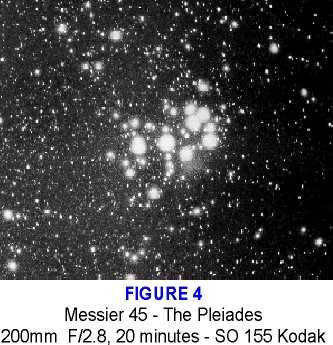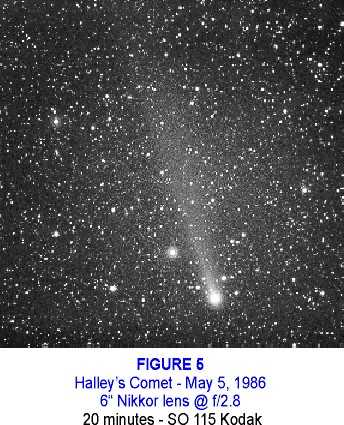OBSERVER'S GUIDE: GETTING STARTED IN ASTROPHOTOGRAPHY
Last updated: 15 March 2001
OBSERVER'S GUIDE: GETTING STARTED IN ASTROPHOTOGRAPHY |
Many people are mesmerized by the fantastic photographs they see of celestial objects....indeed, many people actually BUY a telescope because of these photographs. Likely, the very package that YOUR telescope came in - the catalog that advertised it.....the instruction manual that came with it....are ALL laden with glorious full-color photographs of celestial splendors.
You look at these images, say of Saturn and its magnificent colors, and you ask yourself: "When is it time for ME to take pictures like that?"
We have a lot of inquiries concerning the suitability of the ETX telescope for deep sky photography; the many published and beautiful photographs of the moon, sun and planets taken through ETX and other compact telescopes eludes to the fact that these telescopes CAN "do" astrophotography.
But - in the harsh, hard reality of the proverbial "nutshell" - these telescopes ARE not suited for long-exposure PRIME FOCUS astrophotography. Don't give up just yet....there is PLENTY of good photography that CAN be done in addition to lunar and planetary imaging.
----------------------------------
PRIME FOCUS ASTROPHOTOGRAPHY
Photographing at the "prime focus" of a telescope is a very simple and straightforward procedure, yet all telescopes are not suited for LONG EXPOSURE prime focus work. Long exposures are required to capture the images of nebulae, galaxies and faint clusters unless a CCD imager is used which is also very awkward to use on a compact and small telescope.
Imaging a photograph being like a sponge: a drop at a time and eventually the sponge becomes "wet," holding as much water as it possibly can. The film or electronic sensor in a CCD is the same way....over longer and longer periods of time (or with more and more exposures in the case of CCD), the light eventually "accumulates" and becomes brighter and more clear on the film.
In prime focus photography, the telescope (say an f/15 ETX) becomes the CAMERA LENS; with the standard camera lens removed with the ETX 125 for example, and the camera attached at the rear of the telescope you have essentially a 1,900mm telephoto lens!
This is great for relatively short exposures of the sun, moon and planets and certainly for nature photography, but the long focal length ALSO "magnifies" the length of time required for that "sponge" to soak up enough light, it adds to the vibration and motion as the picture is being taken, and it requires VERY CAREFUL guiding using a "drive corrector," which is not normally an option with the ETX and other compact computerized telescopes.
So, except for the wonderful experience of lunar and planetary photography - which I certainly urge you to undertake and experiment with - let us explore what other option is available to you to capture images of the wonders of DEEP SPACE!
----------------------------------
MOUNTING A CAMERA PIGGYBACK
The ETX telescope may not be ideally suited for long exposure photography at the prime focus, but it is HEAVILY favored when it comes to "piggyback astrophotography." The short, stubby tube on its sturdy (yes, I said "sturdy" for all you anti-plastic protestors out there.....all things considered and all clamps securely locked, the ETX is one of the most steadfast telescopes on the market today!) mounting is PERFECT for long exposures using your CAMERA and a regular or long telephoto lens.
In such photography, you may chose to "not guide" (for regular or relatively short-focus lenses up to 135mm and for shorter exposures - say less than 8 minutes) or "guide" (for telephoto lenses and any shot that you may take that exceeds 10 minutes, regardless of the lens used).
This photo shows an ETX 125 fully equipped with a Scopetronix piggyback camera mount holding a heavy Canon EOS camera and its regular lens. Note how well suited for balancing and carrying the camera this design of telescope actually is.

Following are the items that are needed to begin your exploration into piggyback astrophotography and your first steps toward compiling and personal collection of deep sky astrophotographs you may never have considered possible with your telescope!
1) A motor-driven TELESCOPE operated in very dark sky conditions; for this, the portable ETX and similar scopes are ideal with their internal (and auxiliary DC) power source. With the ease of celestial alignment and tracking that these telescopes offer, you can be photographing in no time....and with VERY little actual guiding required if your polar alignment is right on target!
2) A piggyback camera MOUNT; although Meade does not make a piggyback mount for either the ETX 125 or the ETX 90, the brackets are available. The one shown in Figure 1 (and a similar one for the ETX 90 and other telecopes) is readily available through www.scopetronix.com . The mount merely clamps around the tube and you position the camera on TOP of the tube as shown and balance by adding weights to the flat "tripod" plate already installed under your eyepiece section of the telescope.
3) Obviously, you must have a CAMERA to do photography and some are more suited than others for these reasons (if you have a choice....if not, simply use what you have!): a) it should be as light as possible; b) it MUST be a Single Lens Reflect (SLR) camera so that you can actually SEE what you are photographing through the viewfinder; c) it would be best if the camera had removable lenses; and d) the camera MUST have a "bulb" or "time exposure" setting so that the shutter can be left open for long periods of time.
4) A CABLE RELEASE is required; this is a long extension cord that allows you to trip the shutter open, lock a small clamp to keep it open for a desired length of time (usually 5 minutes or longer) and then release the shutter to close. Image the "western movies" you have seen with the wagon-drawn old traveling photographer who sets up his box camera, exploding flash and hood - he always has one hand over his head, and the other holding his "cabel release!" All major modern cameras accept these, and some have to be special ordered; nonetheless, you cannot do photography without one.
5) Fast FILM. By "fast" I mean a high ASA rating, at least 400 ASA but higher if possible; all the Kodak films provide good celestial images and true colors with rich reds and blues, ideal for deep sky subjects; however, ASA 400 Kodacolor is about as "fast" as you can go with them. Fuji makes much faster films, but these tend to have a bit of a "greenish" cast to the them and are not as well balanced for celestial objects.
6) GUIDING - for exposures greater than 8 minutes and all done with 150mm focal length and longer lenses, you must be able to either manually or electrically make corrections as the objects move; your motor drive will account for SIDEREAL MOTION, but your alignment may be off, so corrections will be required in BOTH right ascension (azimuth) and declination (altitude). The better you track (use a very high power eyepiece and merely find a bright star near the area you are photographing to center and keep centered) the better will your astrophograph will be....by FAR.
---------------------------------
CHOOSING YOUR SUBJECT
The sky is your limit regarding piggyback photography, with everything from comets and meteors to the Orion Nebula and Andromeda Galaxy (Figure ).

Following are the possible subjects (certainly NOT all-inclusive), the best choice of camera lens and the APPROXIMATE length of time using ASA 400 film for which your shutter must remain open:
1) PLANETARY / LUNAR CONJUNCTIONS - when objects "pair up" in the sky they usually are bright and many times not very close together. Therefore, use your standard 50mm lens or no more than say a 135mm lens and an exposure time of about five (5) minutes MAXIMUM. Guiding is NOT necessary through the telescope. For conjunction photographs, as well as bright naked eye comets, always attempt to place SOMETHING on your horizon in the photograph; this adds beauty and gives a wonderful sense of reference for your photograph!
2) BRIGHT COMETS - For really long comets, your standard 50mm lens will work with exposures of only 5 to 10 minutes; the comet will move slightly different than the stars so for any longer exposures, it will be necessary to TRACK ON THE COMET through your telescope! The fainter and smaller a comet, the longer both the focal length of your lens and the time of your exposure; the photograph of Halley's Comet - even with a huge 6" f/2.8 aerial lens required a very long time to capture the full extent of the comet's tail (Figure 6).
3) CONSTELLATIONS - Always use either a WIDE ANGLE (28-35mm) or your normal 50mm lens to photograph constellations; since most were originally outlined with the naked eye, most key stars are bright and thus require only about five (5) minutes of exposure to capture the outline.
4) METEOR SHOWERS - You really do not even need a piggyback arrangement for this, but only a standard camera lens and exposures of from 10 to 20 minutes with NO tracking. For piggyback, it is interesting to aim the scope and camera directly at the shower radiant for a "depth" effect as the meteors appear to emanate from that point.
5) DEEP SKY - The following photographs show just a small sample of what can be done with a regular camera and telephoto lens on your telescope. Of course, your object will appear larger and brighter if it is one of the more notable deep sky objects; the star clouds of the summer Milky Way are incredible and best captured via piggyback photography (see the shot of M-8 and the Great Sagittarius Star Cloud). Even a common camera can capture more stars than can be counted!
The accompanying photographs will provide some frame of reference both the image scale and to the length of exposure time on ASA 400 film.
Take those "first steps" into astrophotography. You can literally spend the rest of your life enjoying piggyback photography without EVER exhausting the supply of celestial subjects!
As my dad always reminded me.....we may not have what all the other folks have. But what we DO have, we sure use it a lot better than they do with what THEY'VE got!
[ mike - group ALL other figures here: "piggyback2 (actually Figure 2) through "piggyback5" (Figure 5)




P. Clay Sherrod
Arkansas Sky Observatory
Conway / Petit Jean Mountain
Arkansas
Return to the top of this page.
Go back to the Observational Guides & References page.
Go back to my ETX Home Page.